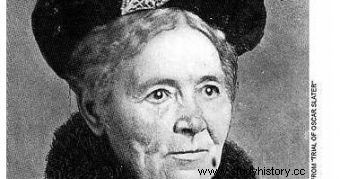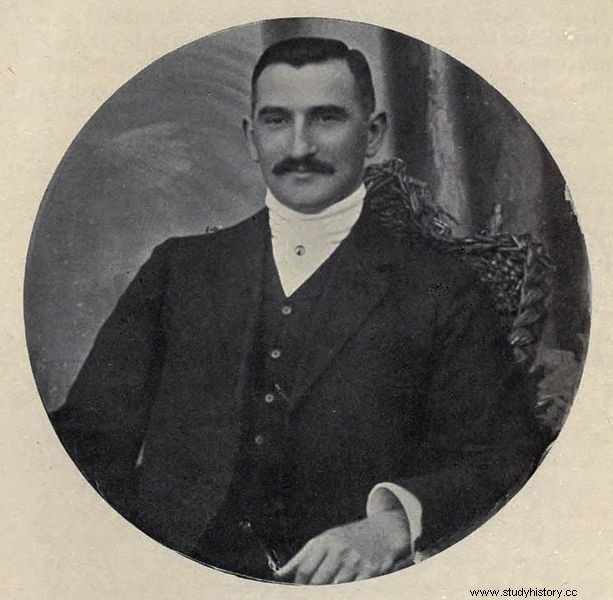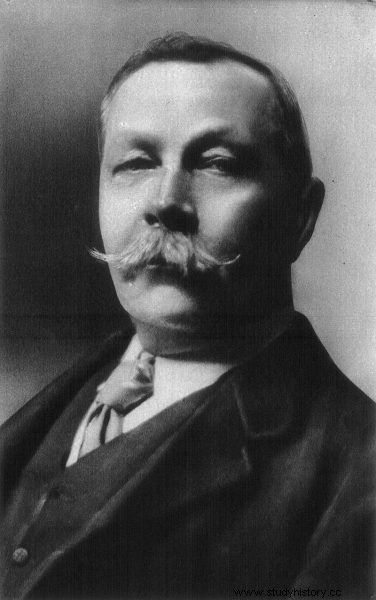On December 21, 1908, Miss Marion Gilchrist was murdered. She was a pious, honest, intimidating woman of perfect health and impeccable manners - in short, she was not very popular. The crime was extremely brutal and became "the loudest murder of the age". Especially since an innocent man was convicted of committing it.
Miss Gilchrist would be 83 in a few weeks. She was an extremely wealthy woman with minor quirks, therefore her way of life was considered eccentric. She lived in an upstairs house in Glasgow with her maid Lambie, whom she had sent for a newspaper on the evening of December 21. After about 10 minutes, the maid, returning to the apartment, met a neighbor disturbed by the noise in front of the door. They opened the door, from which a man stepped out very calmly, walked by and sprang to run on the stairs.

The murder of Marion Gilchrist was one of the most famous cases in the early 20th century
Moments later, in one of the rooms, a maid found the body of her employer on the floor . Her body was facing the door with her legs and a leather rug covered her head. Miss Gilchrist lived for a few more minutes, though almost all of her bones in her face and skull had been so massacred that her face was not in the least of a human face.

Oscar Slater's hammer
Diamond Brooch
Miss Gilchrist has lived a modest life for a wealthy woman with a net worth of about £ 15,000 (now about $ 2 million). She had one weakness - she loved jewelry and collected it en masse . The value of the collection after her death was estimated at £ 3,000 at the time, which would be around $ 400,000 today.
The old lady was terrified of the thieves That's why not only did she not wear more than one item at a time from her extensive collection, but also hid them in various strange places in her apartment:she put them between her clothes, pinned them to the curtains, or hid them in the pockets of her clothes. It was an element of this collection - a diamond-studded brooch that became one of the final pieces of evidence in her murder case. The maid told the police that the brooch was stolen on the day of the murder.
Information about the brooch was quickly disseminated, especially among pawnbrokers, and very soon a bicycle dealer reported that this was exactly the brooch that Oskar Slater, a German Jew who had recently moved to town, was trying to pawn at the pawnshop.
"Disgusting collusion in which stupidity and dishonesty played an equal role"
As Margalit Fox writes in his book, Arthur Conan Doyle and the Murder Case. The Real Investigation of the Creator of Sherlock Holmes ”- what happened next was the most tragic court farce of the era. The next spring, Oskar Slater, who had previously been tracked by the police, was brought to trial because the authorities wanted to prove that the newcomer was supposed to make a living from gambling.
His life was an offense to the sensitivities of people living in the remnants of the Victorian era. Not only was he described as a dandy, but his companion was a supposed revue singer, who in fact worked rather as a prostitute. Even then, he was charged with "immoral housekeeping."
Slater's trial took place in Edinburgh in May 1909 and was full of inaccuracies, prosecution and judicial errors. Witnesses have been manipulated and bribed, evidence of innocence has been omitted, and false statements have been made. One of the policemen even said goodbye to his career because he allowed himself to express his opinion about the injustice during the ongoing investigation.
One of the pieces of evidence considered crucial was that Slater had set a crescent-shaped diamond brooch in the pawnshop some time before. Nobody cared then that he didn't know the victim. According to the findings, Miss Gilchrist was to tell at least one person that he would be murdered a week before her death. Inaccuracies and pardoning evidence were not taken into account.
The jurors were satisfied with a 70-minute deliberation. A conviction has been given. Death penalty. Three weeks later, 48 hours before the execution of this sentence, the sentence was changed. Slater was to spend his life in His Majesty's Prison in Peterhead, Northern Scotland, working in the quarries.
Paving granite and frequent stays in solitary confinement
Here's how Oskar Slater spent most of his time in his sentence. Peterhead Jail was very strict. Even conversations between prisoners were forbidden here, except for those related to work. His case could not be reconsidered because at that time the institution of a court of appeal did not yet exist. For most of his sentence, he worked in granite quarries, ate gruel, bread and broth. After 15 years, he was moved from the quarries to work in the carpentry shop.
Inspired by the country's anti-German sentiment, rangers punished Slater more often than others. He was often thrown into solitary confinement for offenses such as talking to a fellow inmate. There was also a case where he was tied as a penalty to a pole and left in the sun for 2 hours . It seems that the complaint made to the prison authorities on this basis did not change the treatment of the prisoner. Slater's health and spirit were in decline, and he was kept alive by the hope that his innocence would eventually be proven and that he would be able to reunite with his family in Germany in his life. This second dream was never destined to come true.

Oscar Slater
Slater saw his only chance in the person of Sir Arthur Conan Doyle, who, in addition to his fame as the writer of the Sherlock Holmes crime novels, was known as "the knight of lost cases." The most difficult task was to convey a plea for help in proving innocence. We can imagine that a prison which forbade inmates from talking was not very eager to send out letters urging them to reopen the case. They could only send one letter per period and Slater used this opportunity to contact his family in Germany.
Happy prosthesis and master mind
How, then, did Conan Doyle learn of Oscar's desperate request? Fortunately, his fellow prisoner, 2988 William Gordon, was released from his sentence in 1925 and it was him who was secretly handed over by Slater a short note wrapped in silver foil. During the release activities, Gordon was thoroughly searched, luckily none of the guards thought of checking the contents of his false jaw.

Arthur Conan Doyle
Subsequent events showed that Gordon had fulfilled his promise and delivered this short note to Sir Arthur. Conan Doyle took up the gauntlet very quickly and set to work. Like the hero of his stories, he re-analyzed the evidence, questioned witnesses and looked for answers.
As Margalit Fox writes, his strategy was:
1. Finding the details that the investigators in charge of the case missed
2. Demonstrating the logical errors of the police and prosecutors
3. Finding negative evidence and understanding its meaning
4. Attempting to observe instead of just looking
The actions taken by Doyle were extremely tedious and difficult. It turned out that the network of omissions and machinations related to this process was so woven that it was impossible to prove errors in the procedure. Mainly because showing the faults of some organs revealed the faults of others. And no one wanted to jeopardize their job and reputation just to acquit a person convicted of murder.
However, as a result of Conan Doyle's actions, one year after the Scottish Court of Appeal was established, Oskar Slater's case was re-examined . The charges were dropped and the prisoner was released.
While in prison, Slater lost his German citizenship and was never to return to Germany again to live or even meet his family. Paradoxically, looking at the events that followed in Europe, it could have saved his life. The loudest murder of the era, not only in Great Britain but also in the world, was subject to two investigations. The first was a court farce, leading to the condemnation and nearly killing of an innocent man.
The second was conducted by the world-famous Sir Arthur Conan Doyle - father of Sherlock Holmes and Dr. Watson, "knight of lost causes" which led to the acquittal of Oskar Slater. A detailed step-by-step analysis of this investigation is provided by Margalit Fox in her book Arthur Conan Doyle and the Murder Case. It is here that the reader can learn more about this real-life crime story in a moving and engaging way.
